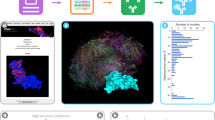Abstract
In previous work, we developed a new algorithm to computationally predict the epitope, the antibody binding surface of a protein, based on aligning individual mimetic probe sequences derived from an experimental process called antibody imprinting for the protein of interest. A program called EPIMAP implements this algorithm and produces a list of the top-scoring alignment(s) of the probe to protein. Typically 50-100 probes sequences will be known experimentally and must be individually aligned using EPIMAP. The goal of the work reported in this paper is to select the most mutually compatible alignments (one for each probe used) in order to improve the accuracy of epitope prediction. We formalize this problem, show that it is NP-complete and describe an effective branch-and-bound search algorithm that works well in practice for inputs of interest. We show in our experimental results section that filtering alignments improves the accuracy the epitope prediction.
Preview
Unable to display preview. Download preview PDF.
Similar content being viewed by others
References
Bailey, B., Mumey, B., Hargrave, P., Arendt, A., Ernst, O., Hofmann, K., Callis, P., Burritt, J., Jesaitis, A., Dratz, E.: Constraints on the Conformation of the Cytoplasmic Face of Dark-adapted and Light-excited Rhodopsin Inferred from Anti-rhodopsin Antibody Imprints. Protein Science 12(11) (2003)
Baker, D., Sali, A.: Protein structure prediction and structural genomics. Science 294(5540), 93–96 (2001)
Blythe, M., Flower, D.: Benchmarking B Cell epitope prediction: Underperformance of existing methods. Protein Science 14, 246–248 (2005)
Bordo, D., Argos, P.: Suggestions for “safe” residue substitutions in site-directed mutagenesis. J. Mol. Biol. 217, 721–729 (1991)
Branden, C., Tooze, C.: Introduction to Protein Structure. Garland Publishing, New York (1999)
Garey, M., Johnson, D.: Computers and Intractability: A Guide to the Theory of NP-Completeness. W.H. Freeman and Co., New York (1979)
Jesaitis, A., Gizachew, D., Dratz, E., Siemsen, D., Stone, K., Burritt, J.: Actin surface structure revealed by antibody imprints: Evaluation of phage-display analysis of anti-actin antibodies. Protein Science 8, 760–770 (1999)
Josephson, K., Jones, B., Walter, L., DiGiacomo, R., Indelicato, S., Walter, M.: Noncompeti-tive antibody neutralization of IL-10 revealed by protein engineering and x-ray crystallography. Structure 10(7), 981–987 (2002)
Mumey, B., Bailey, B., Kirkpatrick, B., Jesaitis, A., Dratz, E.: Revealing Protein Structure: A new method for mapping discontinuous antibody epitopes to reveal structural features of proteins. J. of Computational Biology 10(3-4), 555–567 (2003)
Padlan, E.: X-ray crystallography of antibodies. Adv. Protein Chem. 49, 57–133 (1996)
Roggen, E.: Recent Developments with B-Cell Epitope Identification for Predictive Studies. Journal of Immunotoxicology 3, 1–13 (2006)
Author information
Authors and Affiliations
Editor information
Editors and Affiliations
Rights and permissions
Copyright information
© 2006 Springer-Verlag Berlin Heidelberg
About this paper
Cite this paper
Mumey, B., Ohler, N., Angel, T., Jesaitis, A., Dratz, E. (2006). Filtering Epitope Alignments to Improve Protein Surface Prediction. In: Min, G., Di Martino, B., Yang, L.T., Guo, M., Rünger, G. (eds) Frontiers of High Performance Computing and Networking – ISPA 2006 Workshops. ISPA 2006. Lecture Notes in Computer Science, vol 4331. Springer, Berlin, Heidelberg. https://doi.org/10.1007/11942634_67
Download citation
DOI: https://doi.org/10.1007/11942634_67
Publisher Name: Springer, Berlin, Heidelberg
Print ISBN: 978-3-540-49860-5
Online ISBN: 978-3-540-49862-9
eBook Packages: Computer ScienceComputer Science (R0)




